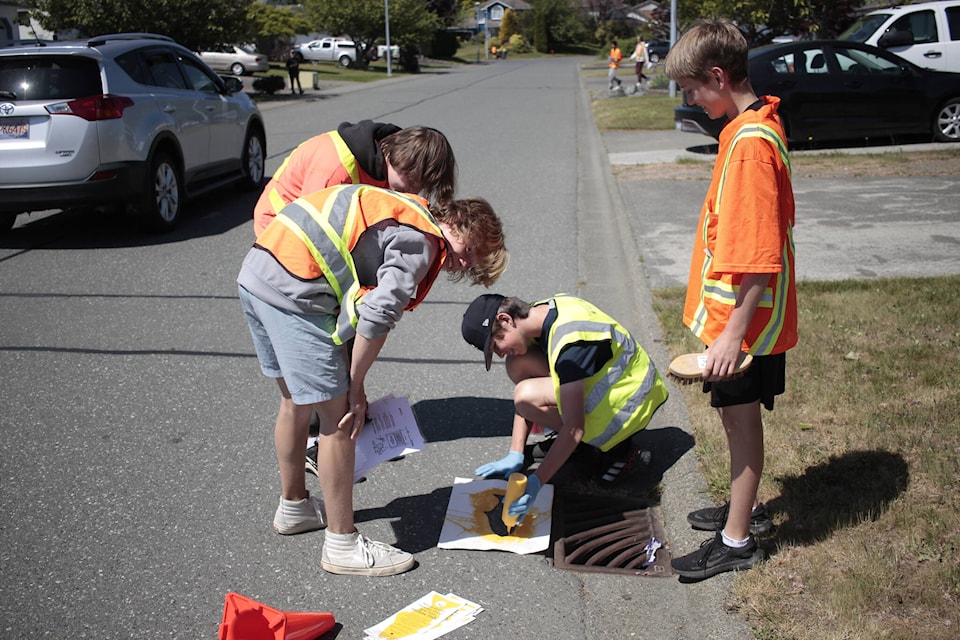After over 2,000 fish died in a Campbell River stream, students at nearby schools wanted to do something so that it wouldn’t happen again.
The solution was well-known, but increasingly rare: storm drain marking.
“It’s a program that’s been going a long time but has not been so popular in recent years, but I feel with the recent die off in the lower tributary that it’s really a great opportunity,” said Deb Cowper, DFO education coordinator who helped facilitate the program. Ttwo classes from Southgate (Middle School) have been doing a lot of watershed studies in this area and care deeply about this and so they just said, yeah, let’s do it.”
After a demonstration by Kyle Fitzpatrick, Greenways Land Trust Education Coordinator, the students walked down Alexander Drive, pausing to paint a stencilled yellow fish in front of each storm drain drain. They also conducted a neighbourhood education campaign, putting door hangings on residents’ front doors to help explain the new markings on the road.
“Whatever you do in your watershed has an impact ultimately down stream,” Cowper said. “Even though we’re here right up at the top of Alexander. When you look at the storm drain Maps the city kindly provided us … It connects right the way down through here through Harrogate and down to actually where the fish kill was. I’m not saying that that’s anybody here has done anything, but you can be so far away and just not realize how you connected to the fish habitat.”
The students have a strong relationship with their watershed. Earlier this year the same class was planting seedlings that they would later plant out around waterbodies nearby. They also have worked with fish conservation, growing salmon from fry to smolt before releasing them in a nearby creek. While those released salmon were in a different system from the mass die off, the students were still affected by the news.
“It was disappointing to see that that happening to our community,” said student Fisher Saxby. “I hope that it (makes) people notice that there are problems that are happening with the creeks that lead to fish die (offs) and it just opens their minds about it.”
Everything from pest and herbicides, paint, chemicals, bark mulch, landscaping plastic, pool chemicals, oil and transmission fluid, other automotive fluids, detergents and waxes, runoff from hosing down walks and driveways, wet concrete from construction projects, garbage and animal waste can all have ill effects on fish within streams. While the source of the May 15 fish die off is still unknown, with test results pending, that kind of event is not unheard-of.
“We get these large scale events and so on but here in suburbia, it’s really this is the odd occasion where somebody does something really silly,” Cowper said. “I heard that there was a fish kill in this area not so long ago when somebody washed out their fuel tanks of their boat directly into a storm drain.
“Cumulatively, if everybody has a little bit of gasoline or oil on the driveway, or a bit of gas or some fertilizer some moss killer for their roof … those little bits add up and down they go.”
The project was part of Greenways’ Junior Streamkeepers program, which has the support of Environment and Climate Change Canada.
See the DFO website online for more information on home tips for healthy streams.
RELATED: Junior Streamkeepers make a difference at Campbell River pond
Over 2,000 fish die due to suspected contamination in Campbell River stream
marc.kitteringham@campbellrivermirror.com
Like us on Facebook and follow us on Twitter
